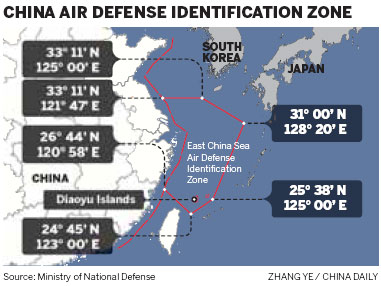China maps out its first air defense ID zone
Updated: 2013-11-24 07:43
By Zhou Wa(China Daily)
|
|||||||
Ministry says move will ensure sovereignty, order and security
China has established its first air defense identification zone in accordance with Chinese law and international practices to safeguard its sovereignty, the Ministry of National Defense announced on Saturday.
The move allows early-warning time and helps China protect its sovereignty and territories, and guarantee regional air security, officials and analysts said.
An air defense identification zone is a defensive area of airspace established by a coastal state beyond its territorial airspace, explained Wang Ji, a Chinese expert on domestic and international law from an institution affiliated with China's air force.
It is used to identify, monitor, control and react in a timely manner to aircraft entering this zone that are potential air threats, Wang said.
The East China Sea Air Defense Identification Zone includes the airspace within the area enclosed by the outer limit of China's territorial waters and six other points.
People's Liberation Army air force spokesman Shen Jinke said two scouting planes have completed the zone's first patrol with the support of surveillance and fighters.
The military is capable of effectively controlling the zone, Shen said. It will not influence international airlines' flights, he said.
The zone was created to safeguard China' sovereignty, territory and security while maintaining flight order, Ministry of National Defense spokesman Yang Yujun said.
"This is a necessary measure China has taken to exercise its right to self-defense," Yang said.
"It is not directed against any specific country or target. It does not affect the freedom of flights in the airspace."
He emphasized China has always respected the freedom of flights in accordance with international law. The zone's establishment does not change the legal nature of the related airspace, and normal flights by international airlines will not be affected.
"The zone's founding has adequate legal basis," Wang said.
"China's domestic laws and regulations, such as the Law of the PRC on National Defense, the Law of PRC on Civil Aviation and Basic Rules on Flight, also clearly stipulate the maintenance of territorial land, air security and flight order."
It is also in line with the United Nations Charter to exercise the right to self-defense, he added.
Naval Military Academic Institute researcher Zhang Junshe said: "The zone shows China's resolve and determination to defend its national sovereignty. It can also help maintain flight security in the region and avoid air accidents. It is in accordance with current international practice."
Since the 1950s, more than 20 countries, including the United States, Canada and China's neighboring countries, such as Japan and South Korea, have successively established air defense identification zones.
On Saturday, the ministry also issued the Aircraft Identification Rules for the East China Sea Air Defense Identification Zone, which states aircraft flying in the zone must abide by these rules and provide identification, including flight plans, radio contact, transponders and logos.
The regulations also require aircraft in the zone to follow the instructions of the zone's administrative organ or the unit authorized by the organ.
China's armed forces will adopt defensive emergency measures to respond to aircraft that do not cooperate in the identification or refuse to follow the instructions, it said.
"We hope all parties concerned work actively with the Chinese side to jointly maintain flight safety," Yang from the ministry said.
The scope of the zone covers China's Diaoyu Islands and is located 130 km from Japan's territory. It overlaps with Japan's air defense identification zone.
The zone is different from territory and, therefore, does not infringe upon other countries' sovereignty, Zhang said.
"The zone's coverage area is determined by China's need for air defense and flight order," said Yang, the ministry spokesman.
"The easternmost point of the zone is actually so close to China that combat aircraft can quickly reach China's territorial airspace from it.
"It is necessary for China to identify any aircraft from this point to assess its intentions and examine its identifiers so as to allow enough early-warning time for responsive measures to maintain air security."
China will establish other air defense identification zones at the right time after necessary preparations are completed, Yang said.
Later on Saturday, Junichi Ihara, director general of the Asian and Oceanic Affairs Bureau with Japan's Foreign Ministry, lodged representations to China's acting ambassador to Japan, Han Zhiqiang, because the zone includes the Diaoyu Islands.
Japan also claims the islands.
But Zhang said Japan's representations are meaningless because the islands belong to China.
Officials of Japan's Ministry of Defense held a meeting and vowed to strengthen surveillance over China, reported China Central Television.
Xinhua contributed to this story.
zhouwa@chinadaily.com.cn

(China Daily 11/24/2013 page1)